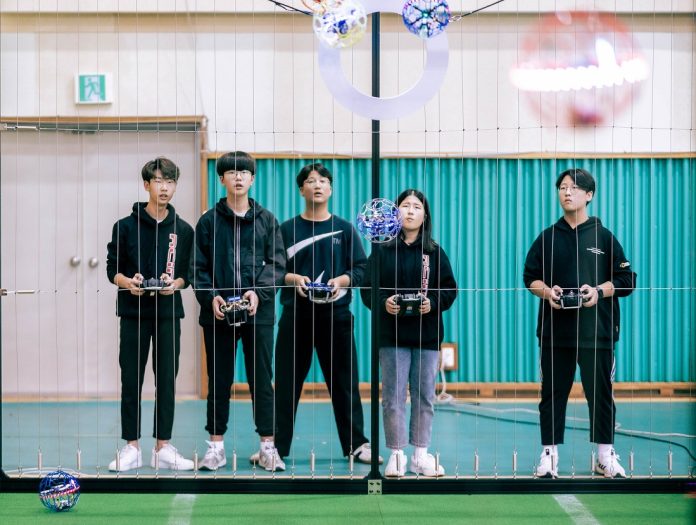Flashing LED drones race through the air, the crowd cheers, and the referee’s whistle pierces the noise: welcome to Drone Soccer, the FAI’s first-ever team sport, a high-octane, high-tech version of football played in the sky.
In this new head-to-head discipline, players work together in fast-paced matches, just like in football or other traditional team sports.
A new kind of team
The concept of a team isn’t new to air sports.
In disciplines such as Formation Skydiving, groups perform synchronised routines. The term is also used for national classifications derived from the individual results of athletes from the same country.
But Drone Soccer redefines what a “team” means in air sports. For the first time, two sides go head-to-head in a match format, each trying to outscore the other in real time.
Another innovation sets this new air sport apart: pilot (or player) substitutions. As in football, Drone Soccer teams can replace pilots between sets (though not during play), using their two named substitutes strategically in response to the unfolding action during the match.
Antonis Papadopoulos, President of the FAI Aeromodelling Commission (CIAM), said:
“We’re very proud to introduce a type of competition that’s completely new to air sports. With substitutions, teams face new tactical challenges. They must read the match, anticipate their opponents’ strengths, and adapt their line-up between sets. But it also means managing different personalities and flying styles within the team, finding the right balance and cohesion to outperform the other side.”

A drone soccer team of five focus on the action. Credit: Yong-chan NAM / KAMA
How do teams play drone soccer?
Drone Soccer is a fast-paced game of skill, strategy, and teamwork. Each side fields several drones — one of which is designated as the “striker”, easily recognisable for spectators with its distinct lights. The striker’s goal is to fly through the opponent’s hoop, a suspended ring just slightly larger than the drone itself.
While the striker attacks, the other team members defend their own goal and block opposing drones. Success depends not only on precision flying but also strong coordination and communication between the pilots, all at lightning speed.
Teams consist of up to three players in Class B or five in Class A, each controlling their own drone from the side of the pitch. All drones are enclosed in protective spherical cages and illuminated in team colours.
Before each match, teams develop a tactical plan, assigning specific roles such as striker or defender. They also build and fine-tune their own drones within FAI technical regulations to best fit their chosen strategy.

A player fine-tunes their equipment set-up in preparation for a match. Credit: Yong-chan NAM / KAMA
How is drone soccer scored?
Matches are played in three sets, each lasting three minutes.
- The team that scores the most goals in a set wins that set.
- The first team to win two sets wins the match.
If a set ends in a tie — whether no goals are scored or both teams are level — the outcome is decided by a penalty shoot-out: three attempts per team, where the striker has 10 seconds to fly through the goal while a defender from the opposing team tries to block the shot.
If the match remains tied after penalties, a sudden-death set begins: the first team to score wins.

Live scoring technology. Credit: Yong-chan NAM / KAMA
How it started
Drone Soccer was created in Korea in 2016 as a way for drone pilots to enjoy the fun of a team sport. Teams and rivalries developed and the game spread until the first international competitions in 2019 when FAI classed it as an official air sport.
The inaugural Drone Soccer World Cup took place in South Korea in 2023 and the first FAI World Championships is being held in Shanghai, China from 15-18 November 2025.
Follow the 1st FAI World Drone Soccer Championship
Header image: Team photo at the Drone Soccer World Cup in South Korea, 2023. Credit: Yong-chan NAM / KAMA







